Please click here to access the main AHDB website and other sectors.
- Home
- Knowledge library
- Cultural and biological control of sciarid and shore flies in protected ornamentals
Cultural and biological control of sciarid and shore flies in protected ornamentals
Management of sciarid and shore flies in protected ornamentals is best achieved using an integrated control strategy involving a combination of cultural and biological control methods.
Integrated control of sciarid and shore flies in protected ornamentals
Cultural control of sciarid and shore flies in protected ornamentals
Cultural control is the basis of any effective integrated pest management (IPM) programme for both sciarid and shore flies. Sciarid fly larvae thrive in moist growing media and infected root tissue. Therefore good nursery hygiene, keeping benches, floors and irrigation equipment clean, removing heavily infested and diseased plant material, avoiding over-watering and giving adequate ventilation to crops are key cultural control methods.
As shore flies feed on algae, the same nursery hygiene and careful irrigation measures will also help to reduce shore fly populations. In addition, pressure washing and disinfecting benches and concrete floors between crops will reduce algal growth as sources of shore fly food and egg-laying sites.
Keeping stocks of growing media covered will reduce the risk of sciarid flies laying eggs and breeding in the media before use. Choice of growing media can help to reduce favourable conditions for sciarid fly development, such as using a proportion of perlite or coir for better drainage. Growing media with a high proportion of green compost led to higher sciarid fly populations than standard peat-based growing media or those containing wood fibre in Horticulture LINK project HL 0193 (HDC/AHDB project PC 283). In the same project, the growing media with a high proportion of green compost also led to the most algal growth and shore fly eggs and larvae.
Long yellow roller traps will catch more adult sciarid and shore flies than standard-sized traps but should be used with care in IPM programmes as they will not control the pests in their own right and will also catch flying beneficial insects.
Horticultural fleece is sometimes used in the early stages of propagation or production to reduce fly egg-laying on the growing media.
Good levels of nursery hygiene and irrigation management are key in the control of sciarid and shore flies

Copyright of AHDB
Biological control of sciarid and shore flies in protected ornamentals
Several biological control agents are available for the control of sciarid and shore flies, and if using IPM with minimal plant protection products, naturally occurring biological control agents can also occur. These are summarised below. Choice, combinations, timings and rates of release or application within an IPM programme should be planned carefully. If necessary, seek advice from the supplier or specialist IPM consultant.
Biological control agents
Entomopathogenic nematodes
Steinernema feltiae is the species recommended for sciarid fly control and is commonly used on protected ornamentals where it can be very effective. Steinernema carpocapsae (recommended for shore fly control – see below) will also kill sciarid fly larvae, however S. feltiae is more effective. The nematode suspension is applied in water as a growing media drench. The nematodes move through the growing media to find a sciarid fly larva and enter the body, where they multiply and release symbiotic bacteria that kill it. The dead sciarid fly larva rapidly decomposes, releasing the nematode juveniles that have multiplied inside the body, and these can then move to find and infect other larvae.
The nematodes need to be applied carefully, following all supplier recommendations. The suspension of nematodes should be kept agitated during application, and the growing media kept moist so that the nematodes can survive and move around. The nematodes are effective in growing media between 10°C and 30°C, depending on product. On highly susceptible crops and in propagation, the nematodes are recommended to be applied preventively.
Research has shown that S. feltiae can be effective against sciarid flies for up to six weeks using sub-irrigation and four weeks using overhead irrigation. However, they are recommended to be applied every two to six weeks in propagation areas, depending on pest pressure and the size of plugs or pots. On highly susceptible crops, growers sometimes apply S. feltiae every week. Routine applications are also usually made to poinsettia crops in the early stages of production, before plant spacing. As sciarid larvae killed by nematodes quickly decompose and cannot be seen in the growing media, the efficacy of nematodes is best assessed by monitoring sciarid fly numbers.
Steinernema carpocapsae is the species recommended for shore fly control. Research has shown that although S. feltiae, used for sciarid fly control, will also infect shore fly larvae, this species does not control shore fly at the rates recommended for sciarid fly control. S. carpocapsae is recommended to be applied every week for shore fly control in propagation areas. Nematode applications should be combined with strict nursery hygiene measures to reduce algae for best effect, particularly during the summer when rapid shore fly breeding occurs.
Sciarid fly larva infected with Steinernema feltiae, the infective nematode juveniles can be seen inside the body
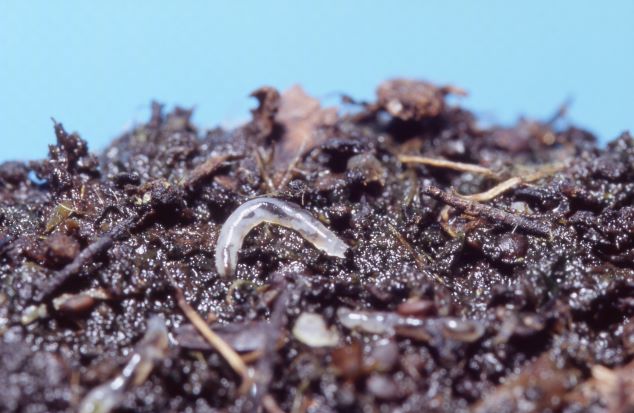
Courtesy and copyright of Ward Stepman, Biobest.
Dalotia (Atheta) coriaria
This ground-dwelling predatory rove beetle is available for control of both sciarid and shore flies. Both the adults and larvae will eat sciarid and shore fly eggs, larvae and pupae in the growing media. They will also eat other prey in the growing media, including thrips larvae and pupae.
The adult beetle is 3–4 mm long, dark brown and shiny, with beaded antennae, short wings and an upturned rear end. The adults are very active and can run and fly but often remain hidden within the growing media and under pots or trays. The young larvae are small and white, while the older larvae reach 3–4 mm in length and are brownish-yellow. D. coriaria is recommended for use in the early stages of infestation.
The higher release rates needed for greater pest densities are expensive, so a ‘DIY’ system for growers to rear their own D. coriaria on the nursery was developed as part of HDC/AHDB projects PC 239 and PC 239a. This research showed that using the ‘DIY’ system could offer a cheaper and equally effective alternative to using high release rates of the commercial product. Some growers are still using this system. However, others have discontinued it due to the time needed to maintain healthy and productive cultures. When used routinely, they can control shore flies on some crops, such as pot rose.
Research in Canada showed that D. coriaria and S. feltiae were compatible in IPM programmes. D. coriaria adults were not susceptible to S. feltiae, and although 13% and 25% of larvae were killed by the preventive and curative rates of the nematodes, respectively, these mortality rates are classed as ‘safe’ and ‘slightly harmful’ using the IOBC (International Organisation for Biological Control) testing scheme for side effects of plant protection products on beneficial organisms.
Dalotia (Atheta) coriaria adult with dark brown body and upturned rear end
 coriaria adult Nigel Cattlin FLPA.jpg)
Courtesy and copyright of Nigel Cattlin.
Predatory mites
Stratiolaelaps scimitus (Hypoaspis miles) and Macrocheles robustulus are ground-dwelling predatory mites commonly used for sciarid fly control and can be very effective. Adult females of both species are up to 0.8 mm long, off-white, with a pale brown shield covering most of the upper surface of the body.
The predators need moist growing media, soil or substrate and temperatures above 15°C. They are supplied in tubs with a peat and vermiculite carrier for sprinkling onto pots, trays, benches and floors. They are very active and can be seen running on the growing media surface or under pots and trays. Both species will also eat other prey in the growing media, such as thrips larvae and pupae and are generally regarded by growers as also giving some reduction of shore flies. However, Machrocheles robustulus is not recommended for shore fly control.
Research in Canada showed that Dalotia coriaria and S. scimitus feed on each other, and in PC 239, when the two species were used together, D. coriaria reduced numbers of S. scimitus. This suggests that the two predators should not be used together in IPM programmes.
Stratiolaelaps scimitus with sciarid fly larva
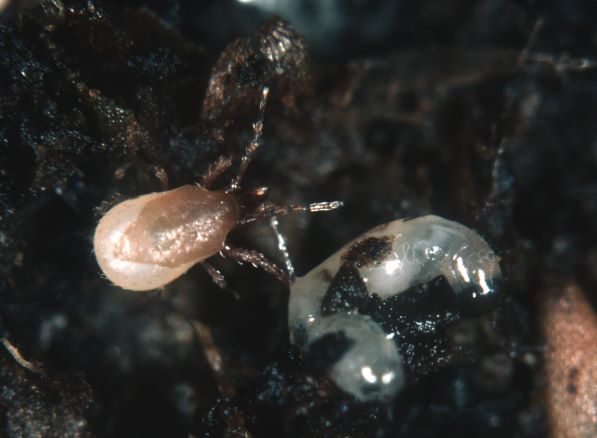
Courtesy and copyright of Nigel Cattlin.
Entomopathogenic fungi
Entomopathogenic fungi are microbiological bioprotectants, and therefore commercial products which need to be approved for use in the UK (unlike predators, parasitoids and nematode biological control agents).
Beauveria bassiana (Naturalis-L) was shown to infect sciarid fly larvae in laboratory tests in Horticuture LINK project 0193 (HDC/AHDB project PC 283), but only low levels of control were given. Beauveria bassiana can also infect shore fly adults and larvae and natural infections are sometimes seen. Two B. bassiana products are approved for use on ornamentals under permanent protection for application as foliar sprays for whitefly control (Botanigard WP and Naturalis-L). Some growers consider that when using B. bassiana, some reductions in shore fly numbers are given, particularly in propagation where relative humidities are high and favour the fungi. However, neither product is recommended for control of either sciarid or shore fly.
Bacillus thuringiensis subsp. israelensis (Bti)
The bacterium Bacillus thuringiensis subsp. israelensis (Bti) has recently gained approval for use on permanently protected ornamentals with full enclosure for sciarid fly control. The product (Gnatrol SC) will not control shore flies. The product is applied as a growing media drench. After being ingested by sciarid fly larvae, the bacteria break down the gut wall, and the larvae stop feeding and die within one to three days. Younger larvae are reported to be more susceptible than older larvae.
Naturally occurring beneficials
Naturally-occurring predators
The ‘hunter fly’, Coenosia attenuata, is a naturally occurring predator of various pests, including sciarid flies, shore flies, leaf miners and whiteflies. They are often seen in protected crops infested with sciarid and shore flies, where IPM is being used.
The greyish adult flies are 3–4 mm long (larger and stouter than sciarid flies) and resemble small house flies. The adult catches its prey in flight, sucks out the body fluids and discards the emptied prey bodies. Their presence is likely if scattered, dry ‘husks’ of prey insects are readily found on plants. C. attenuata larvae are also predatory on ground-dwelling prey such as sciarid and shore fly larvae.
Naturally-occurring parasitoids
Aphaereta debilitata is a naturally occurring parasitoid of shore fly larvae, particularly where IPM is being used with minimal use of plant protection products. In HDC/AHDB project PC 239, A. debilitata was found in large numbers on several UK herb nurseries using IPM and parasitised up to 99% of shore fly pupae on a crop of mint.
The adult parasitic wasps are small and dark, about 1.5 mm long, with narrow ‘waists’ and long beaded antennae. The females have paddle-shaped wings, but the males have very reduced wings and are unable to fly. The adults can be found on the surface of growing media, on benches or floor coverings where shore flies are present. The females lay each of their eggs inside a shore fly larva, and the parasitoid develops inside the body of the larva and pupa. When fully developed, the adult emerges from the parasitised shore fly pupa.
Kleidotoma psiloides is another naturally occurring parasitoid of shore fly larvae, found on UK protected ornamentals in PC 239, which behaves in a similar way to A. debilitata.
Synacra holconata is a naturally occurring parasitoid of sciarid fly larvae, commonly found in UK glasshouses where IPM is used. The adults can often be found on yellow sticky traps used for pest monitoring or on the surface of growing media. The adult is brown, about 2–3 mm long with a very narrow ‘waist’, long beaded antennae and paddle-shaped wings, similar in appearance to A. debilitata. The females lay their eggs through crevices in the growing media into sciarid fly larvae. Development occurs inside the body of the sciarid larva, and later the adult emerges from the sciarid pupa.
Aphaereta debilitata adult female with long, beaded antennae, narrow ‘waist’ and paddle-shaped wings
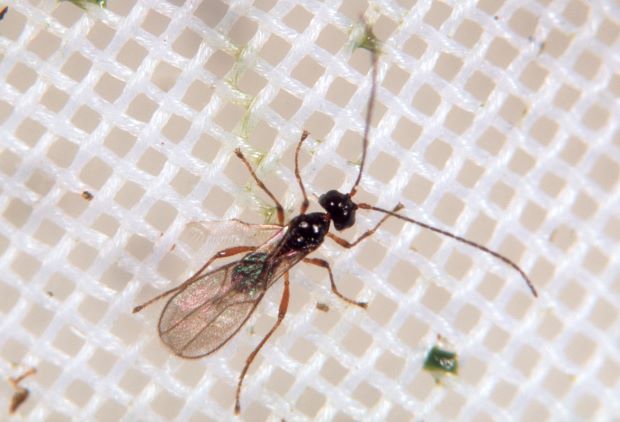
Courtesy and copyright of Nigel Cattlin.
Kleidotoma species adult on a sticky trap
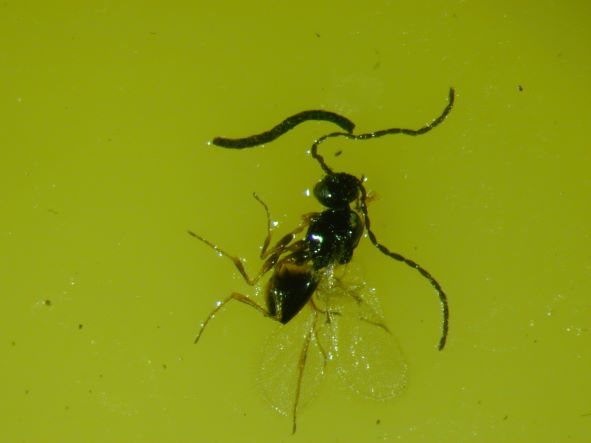
Courtesy and copyright of ADAS Horticulture.
Naturally-occurring entomopathogenic fungi
A naturally occurring fungus, Furia sciarae, that attacks sciarid larvae has been found in recent years on several nurseries growing protected ornamental bedding and pot plants and herbs where growers have adopted IPM. The infected larvae rise to the growing media surface to die, and they have an opaque, milky white appearance. This fungus was investigated in Horticulture LINK project HL 0193 (HDC/AHDB project PC 283).
Shore fly adults naturally infected with a rare, naturally occurring fungus, Torrubiella species, were found on one herb crop in the UK. The fungus produces long rod-like hairs that stick out from the body. This pathogen was also investigated in the same project.
Sciarid fly larva infected with the natural fungus Furia sciarae, with opaque white body
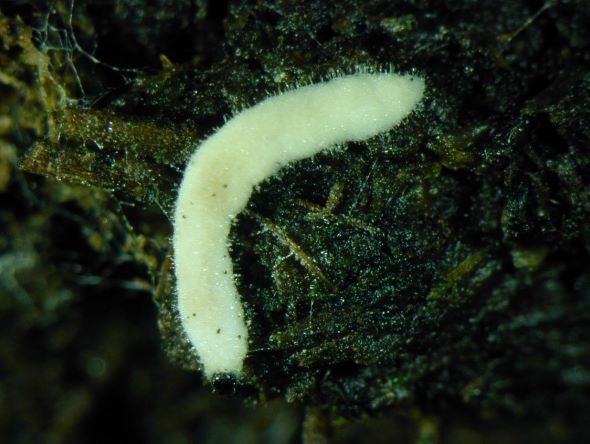
Courtesy and copyright of ADAS Horticulture.
Chemical control of sciarid and shore flies
There are no plant protection products approved or possessing an EAMU for control of either sciarid or shore flies in the UK. Various contact-acting products will kill adult flies when applied for the control of other pests, but control measures for sciarid fly populations are best targeted against larvae due to the continuous emergence of adult flies in protected crops. Management of both sciarid and shore flies is best achieved using an integrated control strategy involving a combination of cultural and biological control methods.
Useful links
More information on control measures can be found in the AHDB report ‘A review of key current control measures for sciarid and shore flies on (SP23)’.
A review of sciarid and shore fly control measures
For more information on the DIY system for rearing Dalotia coriaria, see the AHDB factsheet entitled ‘Grower system for rearing the predatory beetle Atheta coriaria’.
Instructions for creating a rearing system for D. coriaria
Authors
Author – Jude Bennison. ADAS Horticulture.
Original author – John Buxton. ADAS Horticulture.
Webpage content correct as of May 2021.
Topics:
Sectors:
Tags:

